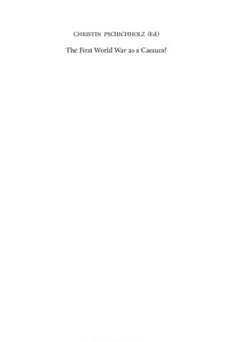
The First World War as a Caesura? Demographic Concepts, Population Policy, and Genocide in the Late Ottoman, Russian, and Habsburg Spheres PDF
Preview The First World War as a Caesura? Demographic Concepts, Population Policy, and Genocide in the Late Ottoman, Russian, and Habsburg Spheres
CHRISTIN PSCHICHHOLZ (Ed.) The First World War as a Caesura? https://doi.org/10.3790/978-3-428-58146-7 Generated for Otto-Friedrich-Universität Bamberg at 77.210.109.158 on 2022-03-01, 14:34:29 1646145269GMTC FOR PRIVATE USE ONLY | AUSSCHLIESSLICH ZUM PRIVATEN GEBRAUCH Gewaltpolitik und Menschenrechte Herausgegeben von Rolf Hosfeld, Sönke Neitzel und Julius H. Schoeps Redaktion Olaf Glöckner und Roy Knocke Band 3 https://doi.org/10.3790/978-3-428-58146-7 Generated for Otto-Friedrich-Universität Bamberg at 77.210.109.158 on 2022-03-01, 14:34:29 1646145269GMTC FOR PRIVATE USE ONLY | AUSSCHLIESSLICH ZUM PRIVATEN GEBRAUCH The First World War as a Caesura? Demographic Concepts, Population Policy, and Genocide in the Late Ottoman, Russian, and Habsburg Spheres Edited by Christin Pschichholz Duncker & Humblot · Berlin https://doi.org/10.3790/978-3-428-58146-7 Generated for Otto-Friedrich-Universität Bamberg at 77.210.109.158 on 2022-03-01, 14:34:29 1646145269GMTC FOR PRIVATE USE ONLY | AUSSCHLIESSLICH ZUM PRIVATEN GEBRAUCH Bibliografische Information der Deutschen Nationalbibliothek Die Deutsche Nationalbibliothek verzeichnet diese Publikation in der Deutschen Nationalbibliografie; detaillierte bibliografische Daten sind im Internet über http://dnb.d-nb.de abrufbar. Cover: Evacuated Civilians in Panowice, Eastern Galicia, Bukovina; © 12. ITD. K.u.k. Kriegspressequartier, Lichtbildstelle – Wien, 12.08.1916, Kriegspressequartier Alben 1914 – 1918, WK1/ALB025/06717, ÖNB All rights reserved. No part of this book may be reproduced, translated, or utilized in any form or by any means, electronic or mechanical, without the expressed written consent of the publisher. © 2020 Duncker & Humblot GmbH, Berlin Typesetting: 3w+p GmbH, Rimpar Printing: CPI buchbücher.de Gmbh, Birkach Printed in Germany ISSN 2566-7696 ISBN 978-3-428-18146-9 (Print) ISBN 978-3-428-58146-7 (E-Book) Printed on no aging resistant (non-acid) paper according to ISO 9706 Internet: http://www.duncker-humblot.de https://doi.org/10.3790/978-3-428-58146-7 Generated for Otto-Friedrich-Universität Bamberg at 77.210.109.158 on 2022-03-01, 14:34:29 1646145269GMTC FOR PRIVATE USE ONLY | AUSSCHLIESSLICH ZUM PRIVATEN GEBRAUCH Contents ChristinPschichholz TheFirstWorldWarasaCaesura?DemographicConcepts,PopulationPolicy, andGenocideintheLateOttoman,Russian,andHabsburgSpheres ......... 7 RonaldGrigorSuny ImperialChoices:PerceivingThreatsandtheDescenttoGenocide .......... 13 MarkLevene Deadly Geopolitics, Ethnic Mobilisations, and the Vulnerability of Peoples, 1914–18 ........................................................ 33 ArnoBarth TheSecuritizationofMinoritiesasaBedrockofPopulationPolicy .......... 49 Hans-LukasKieser EmpireOverstretchedNation-stateEnforced:TheYoungTurksInauguratedthe EuropeofExtremes ................................................ 65 OktayÖzel The Role of Tes¸kilat-ı Mahsusa (Special Organization) in the Armenian Gen- ocide ........................................................... 81 HilmarKaiser ZorDistrictDuringtheInitialMonthsoftheArmenianGenocide ........... 109 HannesLeidinger Systematization of Hatred. Dangers of Escalation and Genocidal Violence in HabsburgWarfare,1914–1918....................................... 125 HeikoBrendel “Our land is small and it’s pressed on all sides. Not one of us can live here peacefully.”PopulationPolicyinMontenegrofromtheLongNineteenthCentury totheEndoftheFirstWorldWar..................................... 135 SerhiyCholiy War as a Model of Population Movement in the Modern World: The Galician PerspectivesintheFirstWorldWar ................................... 159 KonradZielin´ski TheJewsandtheBolsheviks.TheOctoberRevolutionandEscalationofRadical Anti-SemitisminthePolishLandsDuringtheWorldWarIandtheFirstYearsof IndependentPoland ................................................ 179 PeterHolquist TheSovietPolicyofDe-cossackizationDuringtheRussianCivilWar(1919) 191 https://doi.org/10.3790/978-3-428-58146-7 Generated for Otto-Friedrich-Universität Bamberg at 77.210.109.158 on 2022-03-01, 14:34:29 1646145269GMTC FOR PRIVATE USE ONLY | AUSSCHLIESSLICH ZUM PRIVATEN GEBRAUCH 6 Contents Bibliography ........................................................ 217 Contributors ........................................................ 245 https://doi.org/10.3790/978-3-428-58146-7 Generated for Otto-Friedrich-Universität Bamberg at 77.210.109.158 on 2022-03-01, 14:34:29 1646145269GMTC FOR PRIVATE USE ONLY | AUSSCHLIESSLICH ZUM PRIVATEN GEBRAUCH The First World War as a Caesura? DemographicConcepts,PopulationPolicy,andGenocideintheLateOttoman, Russian,andHabsburgSpheres Introduction ByChristinPschichholz WastheFirstWordWaracaesuraregardingdemographicconcepts,population policy,andgenocide?1Giventhemillionsofciviliancasualties,theanswerisimme- diate.ThepoliticsofethnicviolenceattainednewdimensionsduringtheFirstWorld War.Notonlywerecrimescommittedagainstthe‘enemy’populationbyforeignar- mies;violenceinitiatedbystateauthoritiesdirected towardssectionsoftheirown populations involvedunprecedented dimensions of demographic engineering. The post-warperiodwasthusleftwiththeidealofapurportedlyhomogenousnational- isticpeople. OnlywiththeadventoftheSecondWorldWarcouldtheFirstWorldWarbeiden- tifiedasthegreatseminalcatastrophe(Urkatastrophe).GeorgeF.Kennan’stermar- ticulatedtheconnectionbetweenthetwoworldwarsandhasstronglyinfluencedthe search for possible continuities between them. Extensiveresearch in recent years, however, has allowed scholars to grasp the significance of the First World War in its own right and to embed theyears 1914–1918 in the history of violence in the twentiethcenturymoreprofoundlythaneverbefore.Thisalsomeansthattheconflict of1914–1918isnolongerunderstoodasakindoftrialrunforgenocideandradical- izationofmilitaryviolenceinthe20thcentury.Moreover,researchonconflictand violencehasgivenmuchgreaterweighttotheeventsof1914–1918.2Thevarious warsthattookplaceshortlybeforetheGreatWaralreadyanticipatedtheethniccon- flictsandviolencethatoccurredperiodicallythroughoutthetwentiethcentury.Thus, forcedaswellasnegotiatedpopulationshiftswereadministeredandexecutedduring theBalkanwarsof1912–13.ThecompetitionandalliancesbetweentheGreatPow- ers,andthecrisisintheOttomanEmpire,whichemergedclearlyduringtheItalo- TurkishWar,confirmedtotheBalkanstatesthatnationalclaimsweremilitarilyen- 1Thepresentvolumeistheresultoftheconference“DemographicConcepts,Population Policy,Genocide–TheFirstWorldWarasaCaesura?“(September29andOctober1,2016). AboutthirtyinternationalexpertsgatheredinPotsdam,Germany,inordertodiscussdemo- graphicpoliciesinthetimeperiodofWorldWarI.Theconferencewasjointlyorganizedby theLepsiushausPotsdamandtheUniversityofPotsdam. 2Förster,p.19. https://doi.org/10.3790/978-3-428-58146-7 Generated for Otto-Friedrich-Universität Bamberg at 77.210.109.158 on 2022-03-01, 14:34:29 1646145269GMTC FOR PRIVATE USE ONLY | AUSSCHLIESSLICH ZUM PRIVATEN GEBRAUCH 8 ChristinPschichholz forceable.Thesedevelopmentshadthusalreadytransformedtheinternationalsys- tembefore1914.3Withitstransformationofwarfareduetodimensionofindustri- alization, however, the First World War brought about decisive changes, not only ontheWesternFrontintheemblematicformoftrenchwarfarebutalsointheborder regionsofthemulti-ethnicempires,especiallyinthephasesofmobilewarfare–and thusalsoamongtheveryheterogeneouspopulationintheborderregions.4Duringthe FirstWorldWar,theHabsburgmilitarytookactioninthefrontlineareasofGalicia againstitsownUkrainianpopulationaswellasintheBalkansagainstitsownSerb populations,whofoundthemselvessuspectedofdisloyalty.InRussia,expulsionsand deportationsfromdifferentterritorieswereaimedespeciallyagainsttheJewishand Muslim sectorsofthe population,and,inthe courseofthewar,againstPoles and Ukrainians too. In the Ottoman Empire the Armenian genocidewas embedded in anextensivepopulationpolicythataffectedboththeRûmmillet(ofGreek-Orthodox creed),theArab,andtheKurdishpopulation. ScholarshipontheFirstWorldWaraswellasonthepoliticsofethnicityandmass violenceinthelateOttoman,Russian,andHabsburgempireshasestablishedtwoof themostexcitingfieldswithinbothEuropeanandMiddleEasternhistoryinrecent memory.5Thisanthologyseekstocombinebothofthesefields.Althoughthemag- nitudeofradicalpopulationpolicyduringtheFirstWorldWar,withitsprecursorsin theBalkanwars,inthepost-warstrugglesintheOttomanEmpire,aswellasinRussia appearsobvious,surprisinglylittlehasbeenundertakentoviewitfromacomparative perspective,6althoughdoingsocouldhelptoclearupmanyquestions:IftheFirst WorldWarwas aturning point,howcan itbedescribed? Didthewar,whichwas perceivedasastruggleforsurvival,turnregionalconflictsintoglobalones,thusrad- icalizingthem?Ordidcertainstatesexploitthestateofwarwithinaglobalconfla- grationtosolveregionalconflictsquicklyandinaradicalway?Wereradicalpop- ulationpoliciesobservedandutilizedtocreateamodelforothercountries’ownpop- ulation policies? In what way were military plans and domestic measures inter- twined? To what degree did state authorities that undertook and organized population policies before the war still play a part during and after the war? And what factors distinguished the Ottoman Empire from other multi-ethnic empires suchthatthemostradicalpopulationpolicywasimplementedthere,settinggenoci- dalprocessesinmotion? In1915,andinthewakeofanunsuccessfuloffensiveagainstRussia,theCentral Committeeof Unionand Progress (CUP)organized thedeportation of Armenians fromtheareaoftheCaucasusandPersianmilitaryfrontstotheSyriandesert.Official 3Geppert/Mulligan/Rose,p.17. 4Überegger,„VerbrannteErde“,241–278. 5Campos; Chokobaeva; Provence; Dornik/Walleczek-Fritz/Wedrac; Gingeras; Kirmse; Robson;Reynolds. 6Comparative aspects also showed in a wider time frame Barkey/Von Hagen; Barkey; Reynolds. https://doi.org/10.3790/978-3-428-58146-7 Generated for Otto-Friedrich-Universität Bamberg at 77.210.109.158 on 2022-03-01, 14:34:29 1646145269GMTC FOR PRIVATE USE ONLY | AUSSCHLIESSLICH ZUM PRIVATEN GEBRAUCH TheFirstWorldWarasaCaesura? 9 militaryreasonswerecited:ItwasassumedthattheArmenianswereplanninganup- risinginordertosupporttheRussianforcesfrombehindtheTurkishlines.Thede- portationsweresoonextendedtoallArmenianslivinginAsiaMinor.Morethana millionwoulddieduringtheyears1915–1917.7 ThestrugglefortheadequateremembranceandrecognitionoftheArmeniangen- ocidestillaffectsrelationsbetweennumerousstateseventoday.TheCaucasusre- gion,theclosedborderbetweenArmeniaandTurkey,theNagorno-Karabakhcon- flict,aswellasinternalTurkishconflictsserveasexamplesinthisregard.Thecom- plicatedandtense(geo-)politicalsituationinvariousconflictregionshaspreventeda frankandopendiscussionofablatantatrocityasacaseofgenocide.Turkey,asthe successor-state to the Ottoman Empire, has struggled to cope with the profound moral distress and the loss of authority arising from its association with a crime againsthumanity.Scarcelyanyotherissueclarifiesthesignificanceofnationalnar- rativesandthecomplexitiesinvolvedinthemutualunderstandingofhistoricalinter- pretationasmuchastherecognitionofthegenocideagainsttheArmenianpeople: Contrastinginterpretationsoftheeventhavebecomedeeplyrootedandhavecometo compriseafundamentalcomponentofnationalidentity.Overthelasttwentyyears, however,thetopicoftheArmeniangenocidehasundergoneaprocessofnormaliza- tionintheintellectualdebate,withpositiveresults.Withinthiscontext,twoaspects shouldbehighlightedthathaveimprovedtheresearchandacademicdiscourseonthe Armeniangenocide.First,moredifferentiatedempiricalresearchhasemergedfrom theacademiccommunity,yieldingmanynewfindings.Second,theresearchitselfhas become more international.8 The intensive studies on the Armenian genocide that havebeenconductedoverrecentyearshavemainlychallengedoldernationalnarra- tivesandparadigmaticreductions.Theobsessivesearchforthe“smokinggun”inthe faceofTurkishdenialismcontinuestoexist.Atthesametime,theyoungergenera- tionofscholarsinparticularhasbrokenwithone-dimensionalexplanatorypatterns.9 Thisnewresearchhascenteredonempiricalresultsinthecontextofsocial,econom- ic,geo-politicalanddemographicdecision-makingprocesses,andonunderstanding the Armenian genocideas a part ofthewider CUP programme.10By contrast, the focus of relevant academic works that have been written in the 1980s and 1990s waslessonthecontextualizationthanontheproofofintent,andthusonthejustifi- cationofthetermgenocide.ThisfocusculminatedinacomparisonwiththeNazi crimesand,asinthecaseofVahaknN.Dadrian,inanadditionalanalogybetween theJewishpopulationintheGermanReichandtheArmenianpopulationintheOtto- manEmpire.11Understandably,thecomparisonwasintendedtoservethenecessary 7ThenumberofvictimscitedintheliteratureandthecontroversyregardingthisseeBijak/ Lubman,26–43. 8Forrecenttrendsseeindetail:DerMatossian;Pschichholz,p.15,25–31. 9Completelyagainsttherecenttrend:Morris/DrorZe’evi. 10E.g. Erol, Macedonian Question; Üngör, Fresh Understandings; Kaiser, Armenian Property;Üngör/Polatel. 11Dadrian,TheConvergent,p.151-169. https://doi.org/10.3790/978-3-428-58146-7 Generated for Otto-Friedrich-Universität Bamberg at 77.210.109.158 on 2022-03-01, 14:34:29 1646145269GMTC FOR PRIVATE USE ONLY | AUSSCHLIESSLICH ZUM PRIVATEN GEBRAUCH 10 ChristinPschichholz andlaudablepurposeofraisingawarenessoftheatrocity.Fromascholarlyperspec- tive,however,thegaininknowledgeremainedlimited. Thesekindsofcomparisons,aswellasthemanyvariationsinthedefinitionsof genocide,leadtothequestionoftheextenttowhichtheconceptofgenocideishelp- fulforhistoricalanalysisandwhetheritshouldnotsimplybeomittedbecauseofits instrumentalizationasa“politischerKampfbegriff”(forthepurposesofintervention, media attention or unanimous condemnation).12 But the term genocide is indeed meaningfulwhenphenomenaofviolenceareseencloselyintheirhistoricalcontext andincomparisonwithmassviolencethattookplaceintherespectivetemporal,po- liticalandmilitarycontexts.Itisnotamatterofdescribingotherformsofmassvio- lenceas“only”ethniccleansing,ethnictensionsorpogromsofshortduration,and thususingthemasayardstickforahierarchyofcruelty,butrathertoobtain,through thecomparativeperspective,startingpointsfordeterminingexactlywhatledtomass violenceandwhatcircumstancesweakenedorpromotedtheprocessleadingupto genocide. OnlyincomparisontomassviolencethatdidnotendasradicallyastheArmenian case,doesthespecificallygenocidaldimensioninthecontextoftheFirstWorldWar becomeclear,forinotherborderregionstheconditionsoftheconflictsarenotdis- similar.Itispreciselybymeansofjuxtapositionwithnon-genocidesthattheconcept ofgenocidecanfindaplaceinempiricalhistoriography,whosegreatercontextual- izationpromisesamuchmorefar-reachinganalysisthananyreferencetotheviolent crimesoftheSecondWorldWarcouldprovide. Thefollowingessayscombinedifferentaspectsofandperspectivesonthedem- ographicpoliciesbefore,during,andafterWorldWarI.Preciselybecauseofthedif- ferencesbetweentheexaminedcases,thesimilaritiespresentedappearevenmore interesting.Themoststrikingexampleisperhapsthesignificantdegreeofinternal conflictexperiencedbymanystates,andtheextenttowhichthisaffectedtheirex- ternalpolicies.Thefirstthreeessaysdealwiththecorequestionsfromatransnational perspective.RonaldG.SunyandMarkLeveneapproachthetopicbytreatingthede- velopmentsduringthewarasaEuropeanintertwinedhistoryofethnicviolence,and byexaminingtheYoungTurkisheliteintheOttomanEmpireinthecontextofthe Europe-widedebatesaboutnationalization,ethnichomogenization,andtheradical- ization of violence. Arno Barth‘s contributionpresents methodological considera- tions for further analysing early twentieth century populationpolicy. For thispur- pose,heusesinsightsdrawnfrombothpsychologyandpoliticalscience. Thefollowingessaysthentakeageographicalfocus.Hans-LukasKieserlooksat theOttomanEmpire,givinganaffirmativeanswertothequestionofwhethertheFirst WorldWarconstitutesacaesurainmodernhistoryconcerningthepracticeofdem- ographicengineering.Indoingso,however,hedepartsfromthecustomarychronol- ogy,addressingnotonlytheFirstWorldWarof1914–18,butthedecadeof1912–22 12Gerlach,p.455–471. https://doi.org/10.3790/978-3-428-58146-7 Generated for Otto-Friedrich-Universität Bamberg at 77.210.109.158 on 2022-03-01, 14:34:29 1646145269GMTC FOR PRIVATE USE ONLY | AUSSCHLIESSLICH ZUM PRIVATEN GEBRAUCH
